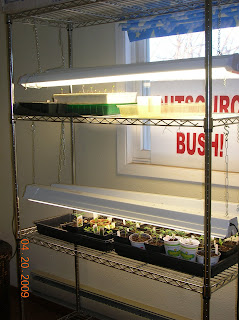 I planted many brusselsprouts, cabbage, and broccoli seeds, indoors, a couple of weeks ago. I planted them in very small pots, and was planning to transplant them to larger pots once they developed true leaves. Tonight, I judged many of them to be ready to repot, so I filled a bunch of 2x2" plastic pots with moistened potting soil--luckily it's now warm enough outside in the evening to do this somewhat messy job outdoors on my work table--and prepared all the necessary other items, consisting of one chopstick (to make the hole), a plastic fork (to remove the little seedling from its dirt bed), a container with water, and strips cut from a yogurt or cottage cheese container to serve as plant markers/identifiers. The latter is a great way to reuse the many yogurt containers I have on hand.
I planted many brusselsprouts, cabbage, and broccoli seeds, indoors, a couple of weeks ago. I planted them in very small pots, and was planning to transplant them to larger pots once they developed true leaves. Tonight, I judged many of them to be ready to repot, so I filled a bunch of 2x2" plastic pots with moistened potting soil--luckily it's now warm enough outside in the evening to do this somewhat messy job outdoors on my work table--and prepared all the necessary other items, consisting of one chopstick (to make the hole), a plastic fork (to remove the little seedling from its dirt bed), a container with water, and strips cut from a yogurt or cottage cheese container to serve as plant markers/identifiers. The latter is a great way to reuse the many yogurt containers I have on hand.Not all of the seedlings are large enough yet to transplant, so after this evening's efforts, I have 18 newly-transplanted pots of mostly brusselsprouts with a few red cabbage thrown in. Yet to transplant are more brusselsprouts and then some broccoli seedlings - those are growing more slowly than the other plants. I'm pretty sure I'll be able to find space under the lights for everybody.......I hope to be able to move the cool-weather brassicas to my cold frame after a couple of weeks so I can make room for the annual flowers I'm growing from seed also.
The lights setup I have is shown in the image - it works really well. It's a large, four-shelf shelving unit, and the metal slats are perfect for hanging fluorescent lamps on. I have enough lamps (4) for only two of the shelves to be functional for growing. I put two lamps side-by-side so the plants get complete coverage. I could improve the light distribution by using aluminum foil as sort of a curtain over each of the lamps to reflect the light back to the plants, but I haven't gotten it that much together. I have all the lights on timers, and they're on from about 6AM to 10PM, so 16 hours. Believe it or not, plants need the night time hours to do their own thing (they don't really rest, they actually do plant activities, whatever those are); what I've read is that they should be in the dark at night, just like we are!





